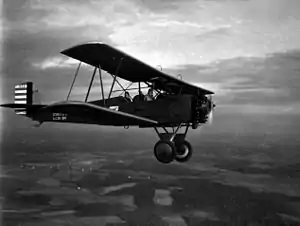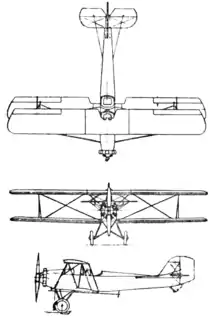| O-17 Courier | |
|---|---|
 | |
| A Maryland Air National Guard Consolidated O-17 | |
| Role | Observation |
| Manufacturer | Consolidated Aircraft Company |
| First flight | April 1927 |
| Primary users | United States National Guard Royal Canadian Air Force |
| Produced | 1928 |
| Number built | 35 |
| Developed from | Consolidated PT-3 |
The Consolidated O-17 Courier (company designation Model 2) was an observation and training aircraft used by the United States National Guard.
Development
A parallel development to the Consolidated PT-3 series, the XO-17 was a converted PT-3 with such refinements as improved fuselage streamlining, oleo shock absorbers, wheel brakes, balanced elevators and increased fuel capacity.[1]
It was used almost exclusively as a cross-country flying, gunnery, photographic and radio trainer.[2] The O-17 had a removable fairing (carrying a Scarff ring mounting for one .30 cal (7.62 mm) trainable Browning machine gun).
The Royal Canadian Air Force purchased three generally similar aircraft, two Model 7 landplanes and one Model 8 floatplane, the latter with the same float gear as the NY series.
The sole XO-17A was converted from the PT-3 as a demonstrator that failed to secure any orders.[2] It was later fitted with the experimental Packard DR-980 Diesel engine of 225 hp (168 kW).[1]
The Model 15 was also an O-17 type airframe fitted with a Pratt & Whitney R-1340 engine. It too failed to win any contracts.[2]
Variants
- XO-17 (prototype)
- Consolidated PT-3 Conversion with a 225 hp (168 kW) Wright R-790-1 engine, streamlined fuselage, modified undercarriage, increased fuel capacity, provision for dual controls and a dorsal 0.3 in (7.62 mm) gun, one conversion.[3]
- O-17 Model 2 Courier
- Production version for United States National Guard use, 29 built.[2]
- XO-17A (prototype)
- One Consolidated PT-3 converted with a Wright R-790-3 engine intended for export.[3]
- Model 7 (RCAF landplane)
- Royal Canadian Air Force, two built.[2]
- Model 8 (RCAF floatplane)
- Royal Canadian Air Force, one built.[2]
- XPT-8 (demonstrator)
- The airframe of the XO-17A prototype fitted with a Packard DR-980 Diesel engine of 225 hp (168 kw), scrapped in 1932.[1]
- XPT-8A
- A single PT-3A (29-115) similarly converted with a Packard DR-980 Diesel engine with Project Number 'P-564',[4] but returned to PT-3A configuration.[5] The airframe was subsequently lost in a fatal midair with a P-12C of the 17th Pursuit Squadron 2 miles W of New Baltimore, Michigan on 17 December 1931.[6]
- Model 15 (demonstrator)
- Conversion with a Pratt & Whitney R-1340 engine.[2]
Operators
Specifications

Data from Eden & Moeng (2002)[2]
General characteristics
- Crew: two
- Length: 27 ft 11 in (8.51 m)
- Wingspan: 34 ft 5.5 in (10.5 m)
- Height: 9 ft 9 in (2.97 m)
- Wing area: 296 sq ft (27.5 m2)
- Empty weight: 1,881 lb (853 kg)
- Max takeoff weight: 2,723 lb (1,235 kg)
- Powerplant: 1 × Wright R-790-1 radial, 225 hp (168 kW)
Performance
- Maximum speed: 118 mph (190 km/h, 103 kn)
- Cruise speed: 100 mph (161 km/h, 87 kn)
- Range: 550 mi (885 km, 480 nmi)
- Service ceiling: 12,000 ft (3,660 m)
- Rate of climb: 865 ft/min (4.39 m/s)
Armament
- 1 × .30 cal (7.62 mm) M1919 Browning machine gun
See also
References
- 1 2 3 Swanborough, F. G.; Bowers, Peter M. (1964), United States Military Aircraft Since 1909, New York: Putnam, ISBN 0-85177-816-X
- 1 2 3 4 5 6 7 8 Eden, Paul; Moeng, Soph (2002), The Complete Encyclopedia of World Aircraft, London: Amber Books, ISBN 978-0-7607-3432-2
- 1 2 Andrade, John M. (1979), U.S. Military Aircraft Designations and Serials Since 1909, Hinckley, UK: Midland Counties Publications, ISBN 0-904597-22-9
- ↑ "1922-1929 USAAS-USAAC Serial Numbers".
- ↑ Andrade, John M. U.S. Military Aircraft Designations and Serials since 1909. Earl Shilton, Leicester: Midland Counties Publications, 1979. ISBN 0-904597-22-9, page 198.
- ↑ "1931 USAAC Accident Reports".